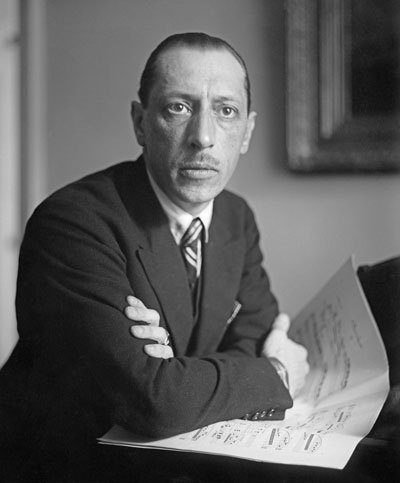Igor Stravinsky

Born: June 17, 1882, Oranienbaum, near St. Petersburg
Died: April 6, 1971, New York City
Scherzo à la russe
- Composed: 1943–44
- Premiere: September 4, 1944 over the NBC Blue Network by Paul Whiteman; orchestral version premiered in March 1946 by the San Francisco Symphony, Stravinsky conducting
- CSO Notable Performances:
- First: December 1965 at a Pops concert, Erich Kunzel conducting
- First CSO Subscription: February 1966, Erich Kuznel conducting
- Most Recent: March 2002, Paavo Järvi conducting
- Recording: Stravinsky: Petrouchka, Firebird Suite, Scherzo à la russe released in 2003, Paavo Järvi conducting
- Instrumentation: 2 flutes, piccolo, 2 oboes, 2 clarinets, 2 bassoons, 4 horns, 3 trumpets, 3 trombones, tuba, timpani, bass drum, snare drums, suspended cymbals, tambour de Basque, triangle, xylophone, harp, piano, strings
- Duration: approx. 4 minutes
In 1943, with war raging in Europe, two of the main sources of Stravinsky’s income—commissions and performance royalties—virtually dried up. To recoup, he sought other work. Living in Hollywood, he reasoned, it was only natural that he should write some music for the movies. He quickly realized, however, that the exigencies of film production would require such wholesale alterations of his ideas that little of his original intention would remain, so the film projects ultimately came to nothing—at least as motion pictures. He did make some sketches for scores for war movies, one set in Norway (those ideas were the basis of the Four Norwegian Moods) and another, set in Russia, which spawned the Scherzo à la russe.
Paul Whiteman, the initiator of “symphonic jazz” and the catalyst for Gershwin’s Rhapsody in Blue, commissioned Stravinsky in 1943 to gather his movie sketches into a brief concert work. Whiteman played the piece over the NBC Radio Network in September 1944, but it had only a modest success, probably because the Scherzo has just the merest hints of jazz and the original version for jazz band created an unhappy marriage of medium and message. Stravinsky took up the score again, and by May 1945 had finished a second version, for symphony orchestra, which better matched the music’s content and sonority. The Scherzo à la russe is now regarded among the finest of the many small, highly polished musical gems in Stravinsky’s output.
The Scherzo à la russe has a distinct flavor of Stravinsky’s native Russia and may have been inspired by an affectionate remembrance of the Russian carnivals he visited as a boy; the work’s scoring and accordion-like chord streams recall the fair scenes from Pétrouchka. The Scherzo à la russe comprises three separate pieces—the Scherzo proper and two intervening trios. The Scherzo is a bright, jaunty tune led by a trio of trumpets punctuated by occasional emphatic climaxes from the full orchestra. The first trio, a canon in close imitation, employs bell-like, Asian timbres from the harp and piano, and is decorated with rapid figurations by the solo violin. The second trio was originally a “little chorus for children,” composed in January 1943 and here given symphonic treatment.
—Dr. Richard E. Rodda